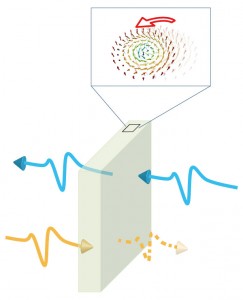Discovery of microwave rectification effect using nano-sized spin whirl skyrmion New principle of microwave response demonstrated


© Yoshinori Tokura and Yoshihiro Okamura, Schematic illustration of the microwave rectification effect via magnetic excitation of the skyrmion. The absorption of an electromagnetic microwave by skyrmion motion depends on the incidence direction.
Magnetism can be found in many materials and is widely used today, ranging from magnets in our daily life to various devices and components, such as the magnetic head in computer disk drives. Magnetism emerges when electron spins order regularly, but complex spin ordering often leads to additional functionalities beyond those of conventional magnets. Recently, a vortex-like spin-swirl object called a skyrmion has been discovered in a magnet with a specific crystal structure. Because of its particle-like character originating from its complex spin texture and its size of the order of tens nanometers, the skyrmion could potentially be used as an information carrier in next-generation memory devices. Now, skyrmions are being studied extensively to search for novel responses to electric and magnetic fields, not only for academic interest but also towards possible applications.
Prof. Yoshinori Tokura, leading a FIRST program “Quantum Science on Strong Correlation”, graduate student Yoshihiro Okamura, Dr. Fumitaka Kagawa at the University of Tokyo and their colleagues discovered that the skyrmion possesses a new functionality, that is, the irradiation-direction-dependent absorption of microwaves. This functionality may open a new avenue for skyrmion-based devices, such as a microwave rectifying device or an inductor with magnetic permeability that is tunable by application of an electric field.
Paper
Y. Okamura, F. Kagawa, M. Mochizuki, M. Kubota, S. Seki, S. Ishiwata, M. Kawasaki, Y. Onose, Y. Tokura,
“Microwave magnetoelectric effect via skyrmion resonance modes in a helimagnetic multiferroic”,
Nature Communications Online Edition: 2013/8/30 18:00(Japan time), doi: 10.1038/ncomms3391.
Article link
Links
Graduate School of Engineering
Department of Applied Physics, Graduate School of Engineering
Tokura & Kagawa Laboratory, Department of Applied Physics, Graduate School of Engineering






